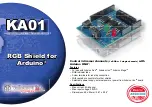UART Modules
MCF52110 ColdFire® Integrated Microcontroller Reference Manual, Rev. 1
Freescale Semiconductor
23-3
Preliminary
23.2
External Signal Description
briefly describes the UART module signals.
shows a signal configuration for a UART/RS-232 interface.
Figure 23-2. UART/RS-232 Interface
23.3
Memory Map/Register Definition
This section contains a detailed description of each register and its specific function. Flowcharts in
Section 23.5, “Initialization/Application Information
,” describe basic UART module programming.
Writing control bytes into the appropriate registers controls the operation of the UART module.
NOTE
UART registers are accessible only as bytes.
NOTE
Interrupt can mean an interrupt request asserted to the CPU or a DMA
request.
Table 23-1. UART Module Signals
Signal
Description
UTXD
n
Transmitter Serial Data Output. UTXD
n
is held high (mark condition) when the transmitter is
disabled, idle, or operating in the local loopback mode. Data is shifted out on UTXD
n
on the
falling edge of the clock source, with the least significant bit (lsb) sent first.
URXD
n
Receiver Serial Data Input. Data received on URXD
n
is sampled on the rising edge of the clock
source, with the lsb received first.
UCTS
n
Clear-to- Send. This input can generate an interrupt on a change of state.
URTS
n
Request-to-Send. This output can be programmed to be negated or asserted automatically by
the receiver or the transmitter. When connected to a transmitter’s UCTS
n
, URTS
n
can control
serial data flow.
DO2
DI1
DI2
DO1
RS-232 Transceiver
UART
URXD
n
UTXD
n
UCTS
n
URTS
n


















